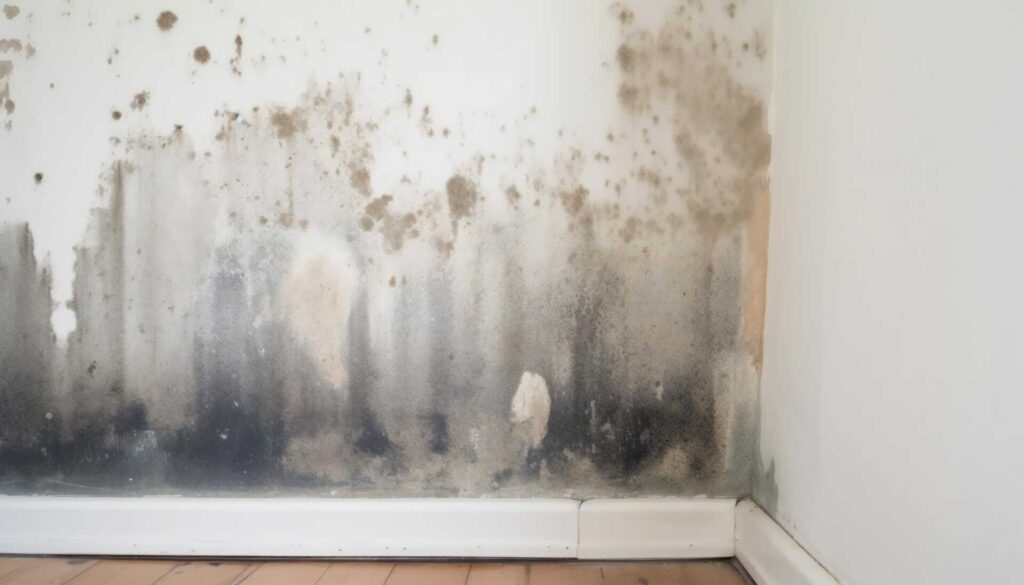
Contents
After a flood, mold can develop within just 24 to 48 hours, making swift action vital. You need to methodically assess the damage and identify all affected areas to effectively tackle the problem. Without a solid plan, you risk leaving hidden spores that could lead to future health concerns. What are the essential steps to ensure thorough mold removal and prevent recurrence? Let’s explore the necessary precautions and techniques you should employ.
Key Takeaways
- Act quickly, as mold can develop within 24 to 48 hours in damp conditions; inspect all affected areas thoroughly.
- Wear proper protective gear, including gloves, masks, and goggles, to safeguard against mold spores and irritants.
- Remove standing water promptly and dry affected areas using fans and dehumidifiers to prevent further mold growth.
- Clean surfaces with a mixture of water and detergent or specialized mold removers, rinsing thoroughly and ensuring complete drying.
- Replace heavily contaminated porous materials, such as carpets and drywall, to eliminate persistent mold risks.
Assessing the Damage and Identifying Mold Growth
When you assess the damage after flooding, it’s essential to act quickly, as mold can begin to grow within 24 to 48 hours in damp conditions.
Start by inspecting all affected areas thoroughly, including walls, ceilings, and floors. Look for discoloration, a musty odor, or visible mold patches, which can indicate the presence of moisture and potential mold growth.
Next, check hidden spaces, such as behind furniture or inside cabinets. Use a moisture meter to measure humidity levels; anything above 60% can foster mold development.
Document your findings with photos and notes, as this will help you track the extent of the damage.
Finally, make a list of materials that need removal or replacement, prioritizing porous items like carpets and drywall, as they’re more susceptible to mold.
Taking these steps ensures a thorough understanding of the situation, paving the way for effective mold removal.
Safety Precautions Before Starting Mold Removal
Before you start mold removal, it’s essential to prioritize your safety by wearing appropriate protective gear, such as gloves, goggles, and masks.
Adequate ventilation is equally important, as it helps reduce airborne spores and chemical fumes during the process.
Taking these precautions will ensure a safer and more effective mold remediation effort.
Protective Gear Essentials
A few essential pieces of protective gear can greatly reduce your risk while tackling mold removal after flooding.
Start with a high-quality respirator equipped with a HEPA filter to safeguard your lungs from airborne spores.
Opt for waterproof gloves to protect your skin from irritants and allergens, ensuring they fit snugly for maximum dexterity.
You’ll also want to wear goggles to shield your eyes from mold particles and cleaning agents.
Consider donning disposable coveralls to prevent mold from contaminating your clothing.
Finally, sturdy, waterproof boots are vital for traversing wet areas safely.
Ventilation Importance
Proper ventilation is essential for ensuring safety and effectiveness during mold removal after flooding, as it helps to reduce airborne contaminants and moisture levels. Before starting, you need to assess your environment. Open windows, use fans, and consider dehumidifiers to improve airflow. Here’s a quick reference table to help you:
| Action | Purpose | Recommended Equipment |
|---|---|---|
| Open Windows | Increase airflow | None required |
| Use Fans | Circulate air | Box or oscillating fans |
| Dehumidifiers | Reduce moisture | Portable dehumidifiers |
| Seal Off Areas | Contain spores | Plastic sheeting |
Gathering Essential Mold Removal Supplies
To effectively tackle mold removal after flooding, it’s vital to gather the right supplies beforehand.
Start with personal protective equipment (PPE) like gloves, masks, and goggles to ensure your safety during the process.
Next, stock up on cleaning solutions, such as a mixture of water and detergent, or specialized mold removers that can eliminate spores effectively.
You’ll also need scrubbing brushes, sponges, and rags for thorough cleaning. A vacuum with a HEPA filter is critical for capturing fine mold particles.
Don’t forget to grab buckets for mixing solutions and disposal bags for contaminated materials.
Lastly, consider a dehumidifier to help manage moisture levels in affected areas.
Removing Water and Drying Affected Areas
Start by removing any standing water as quickly as possible to prevent further mold growth. Use a wet/dry vacuum or a pump to efficiently extract water from affected areas. Once you’ve removed the majority of the water, focus on drying the surfaces thoroughly. Open windows and doors to increase ventilation, and use fans or dehumidifiers to accelerate the drying process.
Here’s a quick reference table to help you identify effective drying methods:
| Method | Description | Timeframe |
|---|---|---|
| Air Drying | Open windows and use fans | 24-48 hours |
| Dehumidifiers | Remove moisture from the air | 12-72 hours |
| Heat Sources | Use space heaters cautiously | 24-48 hours |
| Professional Help | Hire experts if water is extensive | Varies |
Cleaning and Disinfecting Surfaces
Once you’ve addressed water removal and drying, it’s vital to focus on cleaning and disinfecting surfaces to eliminate any remaining mold spores.
You’ll need essential cleaning supplies and a clear understanding of effective disinfection methods to ensure thorough treatment.
Additionally, don’t overlook safety precautions; protecting yourself during this process is paramount.
Essential Cleaning Supplies
While addressing mold growth after flooding, having the right cleaning supplies is essential for effective remediation.
Start with personal protective equipment (PPE), such as gloves, masks, and goggles, to ensure your safety during the process.
Next, gather scrubbing brushes and sponges, which are pivotal for removing mold from surfaces. A solution of water and mild detergent can help lift mold, but you may also need a commercial mold remover for tougher cases.
Buckets and spray bottles are useful for applying cleaning solutions efficiently. Additionally, consider having disposable towels on hand for quick clean-up.
Disinfection Methods Overview
Effective disinfection is essential in the aftermath of flooding to ensure that all surfaces are free from harmful mold spores and bacteria.
Begin by selecting a suitable disinfectant, such as a bleach solution or an EPA-registered product. Make certain to follow the manufacturer’s instructions for dilution and application.
Using a sponge or cloth, apply the disinfectant generously to all affected surfaces, ensuring you cover every nook and cranny. Allow the solution to sit for the recommended contact time to effectively kill pathogens.
Afterward, rinse with clean water and let surfaces dry completely. For porous materials, like carpets or drywall, consider replacing them if they’re heavily contaminated.
This thorough approach ensures a safer, healthier environment for you and your loved ones.
Safety Precautions Required
Cleaning and disinfecting surfaces after flooding require careful attention to safety precautions to protect yourself from potential hazards.
First, wear personal protective equipment (PPE) like gloves, N95 masks, and goggles to shield against mold spores and harsh chemicals.
Verify your workspace is well-ventilated; open windows or use fans, but avoid blowing air directly onto contaminated surfaces.
Remove any porous materials that can’t be cleaned, as they may harbor mold.
Use EPA-approved disinfectants and follow the manufacturer’s instructions for effective application.
Always test surfaces for damage before proceeding, and don’t hesitate to seek professional help if the situation feels overwhelming.
Techniques for Removing Mold From Various Materials
Once you’ve identified the materials affected by mold, it’s crucial to apply specific techniques for effective removal.
For porous materials like drywall and carpet, you’ll need to cut away the affected sections, as mold penetrates deeply and can’t be cleaned thoroughly.
In contrast, non-porous surfaces such as glass or metal can be scrubbed with a solution of water and detergent or a mixture of vinegar and water, making sure to rinse afterward.
For wood, use a mixture of water and bleach—one cup of bleach to a gallon of water—applying it with a scrub brush and allowing it to dry completely. Always test a small, hidden area first to prevent damage.
If you’re dealing with larger infestations, consider professional help.
Preventing Future Mold Growth
After addressing the immediate mold issue, it’s important to implement strategies that prevent future growth. Mold thrives in damp environments, so taking proactive measures is essential.
Here are four effective steps you can take:
Control Humidity: Keep indoor humidity levels below 60%. Use dehumidifiers and air conditioners to maintain ideal conditions, especially in basements and bathrooms.
Ensure Proper Ventilation: Open windows and use exhaust fans in moisture-prone areas. This promotes air circulation, reducing stagnant humidity.
Seal Leaks: Inspect plumbing and roofing for leaks. Repair any issues promptly to prevent water intrusion, which can trigger mold growth.
Regular Cleaning: Clean and dry any areas prone to moisture, like shower curtains and sinks.
Regularly check for mold in hidden spots, addressing any signs immediately.
When to Call Professional Mold Remediation Services
How can you determine if your mold problem requires professional intervention? If you encounter significant mold growth, especially over 10 square feet, it’s time to contemplate calling experts. Also, if you notice persistent odors or health issues like respiratory problems, don’t hesitate to seek help.
Recap
Effectively removing mold after flooding requires a systematic approach, from evaluating damage to cleaning and preventing future growth. For instance, consider a homeowner who discovered mold behind drywall after a flood. By following these steps meticulously, they avoided costly structural damage and health risks. Engaging in thorough ventilation, proper cleaning, and timely replacement of contaminated materials ensured their home remained safe. Remember, diligence in the process is key to a mold-free environment.
Recent Posts
Your Trusted Guide to Flood Damage Repair
It’s essential to act quickly and methodically to mitigate any further issues from flood damage.
Comprehensive Flood Damage Repair Process Explained
Flood damage repair can seem like an insurmountable task, but it’s important to tackle it
What Is the Step-by-Step Flood Damage Repair Process?
When you face flood damage, evaluating the damage, extracting water, and drying the area are
